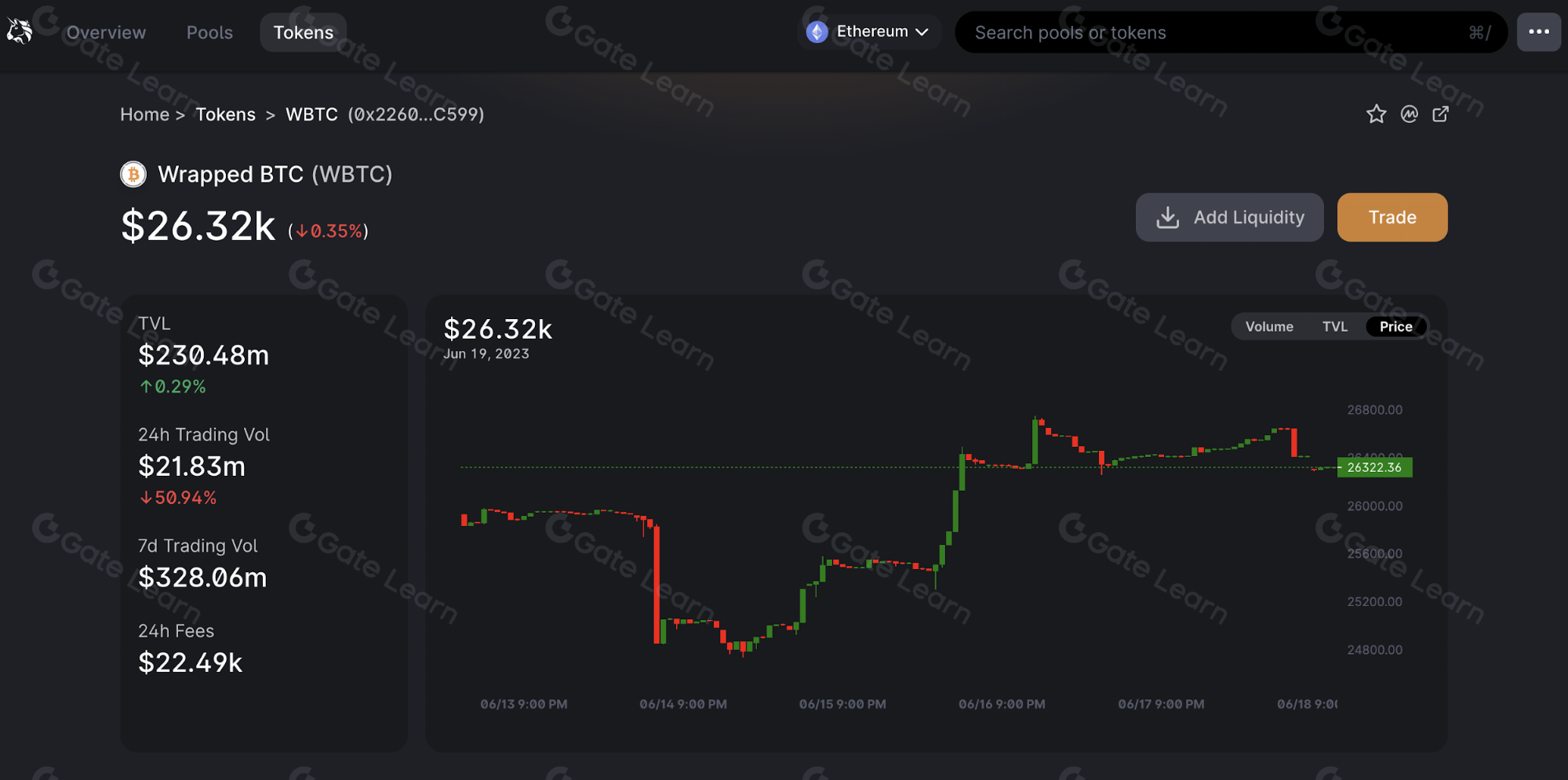The main Wrapped Tokens
In this module, we will explore some of the main wrapped tokens in the cryptocurrency ecosystem. We will take an in-depth look at wrapped Bitcoin (WBTC), wrapped Ethereum (WETH), LidoDAO and stETH, Rocketpool and rETH, and other prominent examples. We will examine their unique characteristics, use cases, and the role they play in expanding the functionality and liquidity of the underlying assets.
Wrapped Bitcoin (WBTC)
Wrapped Bitcoin (WBTC) is a popular example of a wrapped token that is pegged to Bitcoin. WBTC is a tokenized version of Bitcoin that can be used on Ethereum and other compatible blockchains, offering users the benefits of both networks. WBTC is created through a process of wrapping, which involves locking up BTC on the Bitcoin network and issuing an equivalent amount of WBTC on the Ethereum network.

To wrap Bitcoin into WBTC, users first need to choose a WBTC custodian or merchant. These are regulated entities that have been authorized to act as intermediaries between the Bitcoin and Ethereum networks. Once a user chooses a custodian, they need to send their Bitcoin to the custodian’s address, which will then be locked up in a secure multi-signature wallet. Once the Bitcoin transaction is confirmed on the network, the custodian mints an equivalent amount of WBTC on the Ethereum network and sends it to the user’s wallet.
The process of unwrapping WBTC is the reverse of the wrapping process. To unwrap WBTC back into Bitcoin, users first need to send their WBTC to the custodian’s address. Once the transaction is confirmed on the Ethereum network, the custodian releases an equivalent amount of Bitcoin from the multi-signature wallet and sends it to the user’s Bitcoin wallet.
The process of wrapping and unwrapping tokens can have several benefits for users. For example, it allows users to leverage the advantages of multiple blockchains, such as the smart contract functionality of Ethereum and the security and stability of Bitcoin. WBTC also enables Bitcoin holders to participate in the rapidly growing decentralized finance (DeFi) ecosystem on Ethereum, which offers various opportunities for earning yields and accessing new financial services.
However, wrapping and unwrapping tokens also involve risks and limitations that users need to consider. For instance, the process of wrapping and unwrapping tokens may involve fees, transaction delays, and the potential for counterparty risks. Additionally, users need to carefully choose a trustworthy custodian or merchant to ensure the security of their funds.

Source: Uniswap V3
WBTC enhances liquidity on decentralized exchanges (DEXs) and lending platforms. By tokenizing Bitcoin and making it available on Ethereum, WBTC enables Bitcoin holders to participate in the vibrant world of decentralized finance (DeFi). This unlocks additional trading opportunities and grants access to decentralized lending and borrowing services, thereby expanding the liquidity options for Bitcoin in the Ethereum ecosystem.
WBTC also facilitates cross-chain interoperability by bridging the gap between Bitcoin and Ethereum. It enables the seamless transfer of value and assets between the two blockchains, fostering a greater level of interoperability. This is particularly beneficial for users who want to utilize Bitcoin in Ethereum-based decentralized applications (dApps) such as decentralized exchanges, lending protocols, and yield farming platforms.

Source: Aave
Wrapped Ethereum (WETH)
Wrapped Ethereum (WETH) is an ERC-20 token that represents Ether (ETH) on the Ethereum blockchain. It was created to allow Ethereum to participate in the emerging DeFi ecosystem by enabling ETH to be used in smart contracts, DApps, and other blockchain applications that only support ERC-20 tokens.
The process of wrapping Ether into WETH involves depositing ETH into a smart contract, which then mints an equivalent amount of WETH tokens. These WETH tokens are then sent back to the original address and can be used on the Ethereum network like any other ERC-20 token. The smart contract that manages WETH also ensures that each WETH token is always backed 1:1 by an equal amount of ETH held in reserve.

Wrapping Ethereum into WETH allows users to participate in DeFi activities, such as lending, borrowing, and trading, using their ETH holdings. This is because many DeFi protocols only support ERC-20 tokens, and therefore Ether cannot be directly used. By wrapping ETH into WETH, users can leverage their ETH holdings and participate in the DeFi ecosystem without having to convert their ETH into a different ERC-20 token.

Unwrapping WETH back into ETH is a simple process that involves sending the WETH tokens back to the smart contract that minted them, which then burns the equivalent amount of WETH and releases the equivalent amount of ETH to the designated wallet address. It’s important to note that only the user who originally wrapped the ETH into WETH is able to unwrap it, as the smart contract will only release ETH to the address that deposited the original ETH.
WETH has become a popular token in the DeFi space, and is widely used as a form of collateral in lending and borrowing protocols. It’s also a common trading pair on decentralized exchanges (DEXs) and is used as a means of payment for various DeFi services.
One potential advantage of using WETH instead of ETH in DeFi protocols is that WETH can be programmed with additional functionalities that are not possible with regular ETH. For example, WETH can be configured to automatically pay interest to lenders, or to be used as a voting token in governance protocols.
Lido DAO and stETH

Source: Lido DAO
Lido DAO is a decentralized autonomous organization that aims to provide staking services for Ethereum and other blockchain networks. The project is a collaborative effort between multiple blockchain infrastructure companies, such as Chorus One, Certus One, and Bison Trails, as well as individual community members. The DAO’s main objective is to provide a liquid and decentralized staking solution to Ethereum users, allowing them to participate in the network’s consensus mechanism and earn rewards for validating transactions.
One of the unique aspects of Lido DAO is its liquid staking solution. This means that users can stake their Ethereum and receive a liquid representation of their staked assets in the form of “stETH,” which can be traded on various decentralized exchanges or held as a liquid asset. This allows users to earn staking rewards without having to lock up their assets for an extended period. Additionally, Lido DAO has implemented a trustless and decentralized solution to minimize the risk of theft or loss of staked funds.
The Lido DAO operates through a series of smart contracts, with the core of the system being the Lido token, which represents a user’s stake in the network. Users can participate in the DAO’s governance by holding Lido tokens and voting on proposals through the Snapshot platform. Governance decisions include determining the network’s fee structure, selecting network validators, and implementing new features or improvements to the platform.
Lido DAO has expanded its offering to include other blockchain networks, such as Terra and Solana. This expansion allows users to stake their assets on multiple networks and earn rewards, all through the same Lido interface. Furthermore, the DAO has recently launched a liquidity mining program to incentivize users to provide liquidity for stETH on various decentralized exchanges.
Lido DAO introduced a wrapped token called stETH, which stands for “staked ETH.” It represents a 1:1 ratio of the user’s staked ETH and can be freely transferred and traded on the Ethereum network. The purpose of wrapping ETH into stETH is to allow users to participate in Ethereum 2.0 staking while still having a liquid representation of their staked assets. By using a wrapped token, Lido DAO enables users to leverage the benefits of staking rewards while also having the flexibility to trade or use their staked ETH in various decentralized applications (dApps) and DeFi protocols on the Ethereum network.
Rocket Pool (RPL) and rETH

Source: Rocket Pool
Rocket Pool is a decentralized protocol built on the Ethereum blockchain that offers a unique solution for Ethereum 2.0 staking. It provides an alternative to traditional individual staking by allowing users to pool their Ethereum (ETH) together. By pooling resources, users can collectively stake their ETH, which increases their chances of being selected as validators in the Ethereum 2.0 network and earning staking rewards.
The protocol introduces the concept of “minipools,” which are smaller stakeable units. These minipools enable participants with smaller amounts of ETH to contribute to the staking process, ensuring a more inclusive and accessible environment. Rocket Pool’s decentralized architecture ensures that the staking process remains secure, transparent, and open to all participants, regardless of the amount of ETH they hold.
Rocket Pool offers various benefits to participants, including increased staking efficiency, improved security, and enhanced accessibility. By allowing users to pool their ETH, Rocket Pool reduces the minimum requirement for individual staking, enabling a broader range of individuals and businesses to participate in Ethereum 2.0 staking. The protocol also incorporates features such as smart contract automation, decentralized governance, and compatibility with existing DeFi applications, providing a comprehensive and user-friendly staking solution within the Ethereum ecosystem.
Rocket Pool incorporates a wrapped token called rETH, which stands for “Rocket Pool ETH.” It is a representation of the user’s staked ETH within the Rocket Pool protocol. By wrapping ETH into rETH, participants in the Rocket Pool ecosystem receive a token that is tradable and transferable, providing liquidity and flexibility in accessing their staked assets. The wrapping of ETH into rETH allows users to engage with DeFi applications and protocols on the Ethereum network, unlocking the potential to utilize their staked assets while still earning staking rewards. The wrapped token feature enhances accessibility and usability for participants within the Rocket Pool ecosystem, making it an efficient and versatile solution for Ethereum 2.0 staking.
Highlights
- Wrapped Bitcoin (WBTC) is a tokenized version of Bitcoin on the Ethereum blockchain.
- WBTC is created by wrapping Bitcoin on the Bitcoin blockchain into an ERC-20 token on the Ethereum blockchain.
- WBTC provides users with the benefits of both Bitcoin and Ethereum ecosystems, allowing them to participate in decentralized finance (DeFi) and use their Bitcoin holdings in smart contracts.
- WBTC is issued by a group of custodians who hold the underlying Bitcoin and mint the corresponding WBTC tokens.
- WBTC can be traded on decentralized exchanges (DEXs) and used for various DeFi applications, including lending, borrowing, and trading.
- Wrapped Ethereum (WETH) is an ERC-20 token that represents Ether (ETH) on the Ethereum blockchain.
- WETH is created by wrapping ETH into an ERC-20 token, which allows it to be used in smart contracts and other decentralized applications (dApps).
- WETH eliminates the need to convert ETH to other ERC-20 tokens when using dApps, as it can be used directly.
- WETH is useful for liquidity provision in decentralized exchanges and for participating in DeFi applications.
- WETH can be wrapped and unwrapped at any time, with the process of wrapping involving depositing ETH into a smart contract and receiving WETH in return, and the process of unwrapping involving sending WETH to the smart contract and receiving ETH in return.





